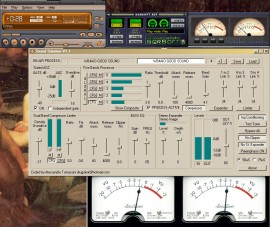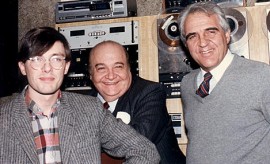
by Kevin Alfred Strom
I’VE RECENTLY BEEN EXPERIMENTING with two plugins (for the popular audio player Winamp) which can create superb music mixes for personal listening, and can even form the core of an Internet or over-the-air broadcast station. As many of you know, I’ve been involved with broadcasting and radio in one way or another for four decades now, so these virtual devices really caught my eye.
The first add-on is Sqrsoft’s free Advanced Crossfading (ACF) plugin, which not only eliminates gaps between songs, but also takes out the several seconds of silence that sometimes plague the beginning and end of downloaded mp3s that you might get from iTunes or Shareaza or your friends’ thumb drives, and that’s not even mentioning its main function — mixing the very last seconds of one track with the first few seconds of the next track, just like a radio station disc jockey might do.
The second is the Sound Solution (SS) v1.1 audio processor by Alessandro Tomassini, a truly amazing piece of free software which can do almost anything that $5,000 FM broadcast audio compressors and limiters can do. One of the main problems with listening to downloaded mp3 and wma files is the wide variation in level that one encounters — one track will be so soft you have to turn the volume nearly all the way up, while the next is recorded so hot it might cause permanent hearing loss at the same setting as the first. SS solves this, and can also make your audio stream more consistent for broadcasting over the ‘Net or via an FM broadcast transmitter large or small.
Advanced Crossfading
ACF is highly configurable, and I found it necessary to decrease the mix buffer size to 8000 ms to avoid white noise and pops on long crossfades. I also tinkered with the maximum and minimum mix time settings as well as the gap killer adjustments, with the end result being a crossfader that does equally well on classical or pop/rock music, with or without jingles between the music tracks. Classical listeners probably will prefer to keep the gaps between pieces, so ACF is most useful for listeners to other genres.
The plugin doesn’t just mix tracks at predetermined intervals — it “listens” to the beginning and end of every track before it is played, and calculates the best timing and duration of the crossfade based on the parameters you set.
ACF automatically converts files with different sample rates to your selected sample rate (in my case, 44.1 kHz), but there is a caveat. I tested ACF with files of 32, 44.1, and 48 kHz rates. Although the upconversion from 32 kHz sounded fine, downconverting from 48 kHz gave a very strident and grainy sound — definitely not recommended. For best fidelity, I suggest using ACF to mix only files with the same sample rate as the ACF output setting — which, since almost all of your music is going to use this rate anyway, will probably be 44.1 kHz.
Good Results
With the settings I eventually settled on (which you can download here and put in your program files\winamp\plugins folder along with the plugin itself after unzipping) I was able to make some very satisfying mixes with never a failure. Most of the time, it sounds like there’s an attentive DJ with a good ear for the right mix point running the show. The plugin’s weakest point is on prolonged, very slow fadeouts, where it tends to let the fade go on too long and defaults to the minimum mix length you’ve set. One could ameliorate this by setting a longer minimum mix length, but I didn’t want to do that since then it wouldn’t work well with very short jingle tracks between songs. All in all, I am somewhere between satisfied and amazed by what the Sqrsoft people have accomplished.
ACF is an output plugin, so it normally wouldn’t have been possible to add final processing (for broadcast audio level control, for example) after it — but the Sqrsoft engineers thought of that. They knew the potential broadcast uses of ACF, so they thoughtfully included the ability to follow the ACF plugin by a final DSP module of your choice. And a good choice, which works well with ACF, is our next subject.
Broadcast-Type Audio Processing

The second free add-on I’ve been working with is Sound Solution v1.1 by Alessandro Tomassini. Having worked with broadcast audio devices from Langevin equalizers and CBS Labs Volumaxes (or is that Volumaxi?) to Orban Optimods, I can say with some authority that what Mr. Tomassini has packed into a free plugin is nothing short of astonishing. It is very nearly the equivalent of a late-model FM broadcast audio processor — for free.
SS might seem intimidating to a novice, with its near total control (via multiple sliders, buttons, and meters) over its input leveler, multiband limiter/compressor/expander, two-band peak limiter and clipper, and stereo expander. But it supports presets, so a knowledgeable user can tweak SS for a particular application, and then send the resulting preset file to anyone, who can then overwrite the equivalent file in his own program files\winamp folder.
One warning about SS: the default setting might not provide the effect you want at all — it sounds like something between WPGC-FM in its bang-the-needles Dorrough DAP days and WLPL-FM in its four LA-3s in stereo-series days. Super-compressed top-40 FM, in other words: fun to play with, but not for everyone.
Also, the SS plugin takes about 30 seconds to initialize — you’ll be convinced it’s not working at all, then suddenly it will kick in. But once it does engage, it is smooth, reliable, and glitch-free for continuous use. There is also considerable latency, so be aware that the meter readings you’re seeing and adjustments you’re making are for the audio you will hear in several seconds. Again, once you’ve got it adjusted and running, that has no negative impact on the user.
Capabilities
It’s possible to approximately emulate broadcast FM or recording processors of almost any imaginable type with this plugin. You can make it sound like a classical FM station with an Orban Optimod 8000 (RMS compressor, no multiband, and two band limiter) or a recording studio “glamorizer” (leveler, low-ratio multiband compressor/equalizer, light limiter with no clipping), a “hot hits” format FM station (like the default preset), or almost anything you can think of.
The one thing SS can’t do too well is final AM broadcast processing. For that you would want symmetry control, brick-wall adjustable low-pass filters, NRSC compatibility, and the ability to completely eliminate FM preemphasis-related limiting. But for a casual user of a small college carrier-current operation or an antique radio dealer’s demo AM transmitter, SS can do a pretty fair job with the right adjustments.
If you use SS in a live announce environment (such as with Winamp’s line in plugin or something similar fed from a mixing desk), be aware that the announcers will go crazy if they listen to the off-air output (because of the delay introduced by SS), so the headphone amps should run off the local mixer’s program feed.
I created a preset file you can download, unzip, place in the Winamp folder, and use with Sound Solution that I call WB4AIO Good Sound. It uses the leveler followed by the multiband compressors operating at a very gentle 3:1 ratio and pretty slow time constants. The peak limiter is turned down to almost invisibility and the clipper and stereo enhancer are turned off.
This gives a pretty aggressive level control — so files varying from barely audible to superhot come out sounding almost equal to the ear — while retaining cleanliness of sound and a great deal of short-term dynamic range. This gives a very open and non-fatiguing result as long as your source files are clean; distorted audio will sound worse than ever when processed. An interesting benefit is that some dynamics actually appear to be added to some overproduced, superclipped modern CD tracks, giving them a more pleasant sound.
Listen to It
If you want to hear what this combination sounds like, I created some files (pretty big .wma files, about 10-12 Mb each) of scoped music (meaning just the first and last bits of the songs are used, to show you what the mixes and dynamics sound like), one with jingles and one without jingles that you can download and listen to with your favorite media player. The original levels on these songs varied tremendously.
Though purists might complain that the wishes of the CD’s engineer and producer are being overridden, for casual listening and Internet radio this preset produces well-controlled yet pleasant audio. The multiband compression brings out details in the mix that you might never have noticed before. For all songs, but especially for murky mixes, it gives an effect approaching remixing and remastering.

The WB4AIO Good Sound preset even works well for FM microbroadcasting (where precise peak control is not enforced) as long as your FM receiver is fairly broadband. My Boston Acoustics table radio and Bose Wave Radio sound great using this preset feeding a little Belkin FM adaptor. A Mercedes ML-series FM car radio was too selective for this preset though, and gave distortion on strong sibilants.
For those requiring tight peak control, I made another downloadable preset called WB4AIO Good FM, which uses the same settings except for the fact that it uses more peak limiting, 75 microsecond preemphasis, and clipping. It works better on narrow FM receivers and sounds as loud as many pop-music broadcast stations, with the sacrifice of some openness and short-term dynamic range. If you want to sound like a top-40 screamer, though, Mr. Tomassini’s default setting is probably better.
The combination of these two plugins makes Winamp into a powerful tool to mix your songs into a seamless, professional-style soundscape.
*Â Â *Â Â *

Kevin Alfred Strom began working in radio broadcasting in 1975, was a staff engineer under Milford K. Smith at Washington, DC’s WPGC from 1976 to 1978, and was chief engineer at WEAM, Arlington, from 1978 to 1984. Since then he has worked as a broadcasting consultant, program producer and host, and editor and publisher. He holds amateur radio license WB4AIO. Some of his favorite ham radio activities include building and modifying AM and SSB amateur gear for better performance and fidelity, and engaging in free-ranging discussions on 160, 75, and 40 meters.
A tip of the hat to fellow AM amateur radio operator Mike Dorrough, KO6NM, inventor of the first multiband broadcast processor, the Dorrough DAP (Discriminate Audio Processor — see, I told you discrimination could be a good thing!); and I hereby dedicate the tweeter-burning highs in my audio chain to Dave Wenger, K3ZRF, whose supermodulated Viking Valiant on 3870 kHz in the 1970s and beyond was an inspiration to me.
